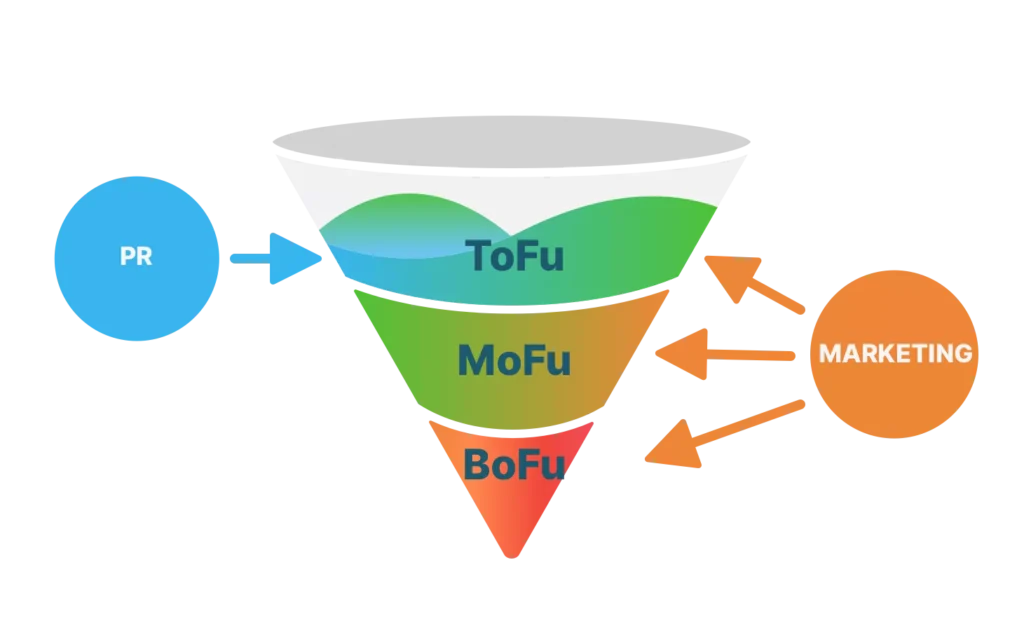You want to grow your business, right? You need customers, investors, and a solid reputation. That’s where PR and marketing come in.
But wait, aren’t they the same thing?
The line between the two is quite blurry and they often overlap, yet they are very different in what they achieve. Which one should you use? Perhaps both of them?
Marketing: The Invisible Sales Guy
Marketing is the business of attracting and retaining customers by promoting and selling products or services. So, anything you see that tries to sell a product or form a connection with a customer is considered marketing (even now you’re being marketed to by reading this blog).
There are many different functions of marketing. The most familiar styles include:
- Outbound Marketing: Creating advertising materials or content that sell to customers directly by reaching out to them. It’s all about shouting your message to the world and convincing people to buy.
- Inbound Marketing: This is more subtle. You’re creating valuable content – blogs, guides, videos – and waiting for potential customers to make the first move. For example, one might be confused and search “Difference between PR and marketing” and end up on an interesting blog page. You’re building trust and making them come to you again.
- B2B Marketing: In ‘Business to Business’ marketing you’re focusing on selling to other businesses. Due to the nature of B2B marketing, you might need more marketing than PR. It’s about building strong relationships and proving your product or service that helps them succeed.
- Transaction Marketing: It’s about making quick one-time sales. You’re focused on individual transactions, not building long-term relationships.
- Relationship Marketing: You’re turning customers into loyal fans. You’re building trust, delivering exceptional service, and making them want to come back for more. For example, you wouldn’t put all your focus into selling someone one expensive car. You would focus on winning their loyalty and being their go-to car brand throughout their whole life.
So, what is PR?
(Personal Record? Puerto Rico?) Nope – Public Relations.
PR is a Reputation Architect. That means you’re shaping how the world sees your company.
You’re not directly selling anything, but you’re building a positive image to attract customers, investors, and the media, cleaning up the messes that a brand might make.
You can be “smart” and use PR as a form of marketing, but more about that in the end.
If you’re going to a press conference and you need someone to train you in what you can and cannot say, you’re going to hire a PR professional. Or, if the public eye catches your employee doing something that might damage your business, not all hope is lost. One of the PR’s goals is to fix crises such as these.
PR is all about:
Media Relations
This involves a huge variety of daily tasks that draw media attention to your company. For example, journalists and broadcasters will share things about your brand through specific media outlets and strengthen your image to the world (clients, investors, stakeholders).
While there are many different ways, both paid and unpaid, that PR teams actually get in contact with media outlets, the outcome should be the same – the media should be promoting the business in a positive light.
Crisis Management
Contrary to media relations, which draw attention toward your company, crisis management draws attention away from your company.
Turning negative situations into opportunities to rebuild your image. A bad review?
Let’s do a public apology, a swift fix, and stay low-key until the dust settles.
PR specialists will elaborate on what happened, be transparent about the event, and remind the world about the positive sides of your business.
Employee Communications
Happy employees can be your best brand ambassadors. But in a larger business, it’s inevitable for some conflicts and issues to arise. That’s why PR teams can work with your employees to see that all conflicts and doubts about your company are resolved.
Also, they can organize fun events and awards to make your workers’ days more exciting and to make them feel valued.
The Big Picture: PR vs Marketing
The Sales Funnel: PR and Marketing in Action

While PR often focuses on the top of the marketing funnel, drawing attention and building brand awareness, marketing works across all stages, from attracting customers to nurturing relationships and driving sales.
Similarities and Differences Between Marketing and PR

Both use content and branding to build trust and reach their target audiences. But here’s the difference:
- Target Audience: Marketing mostly focuses on the acquisition and retention of your customers. PR targets a broader audience, including the media, investors, and the public.
- Focus: Marketing professionals use inbound and outbound marketing, and traditional and relationship marketing to promote your brand and increase sales. PR teams focus on painting the overall picture of your company in a positive light.
- Metrics for Success: Marketing tracks sales, conversions, and ROI, observes the time a customer spends interacting with your content, and evaluates the performance of your media channels. In PR, you measure the amount of positive press about your product or company and the general “hype” about your company in the media.
The Magic of Collaboration
Think of PR as a secret weapon for your marketing strategy.
Each time you do some marketing, you’ll also do some PR.
Each time you do some PR, you’ll also do some marketing.
A well-crafted story can resonate with your audience and drive sales. Why would you only use PR for investors and the media, when you could find a way to appear as the most beautiful company in the world in your customers’ eyes?
Which One Do You Need More?
The answer depends on your business goals and where you are in your journey.
- Early Stages: PR can be invaluable for building awareness and establishing credibility. It can help you attract investors, partners, and customers.
- Growth Stage: Marketing is essential for driving sales and expanding your customer base. It’s about getting your message in front of the right people and converting them into paying customers.
- Established Businesses: Both PR and Marketing are crucial for maintaining your reputation, building loyalty, and staying ahead of the competition.
Takeaways
- Don’t see PR and marketing as separate disciplines. They work together to build a strong brand and drive success.
- PR builds awareness at the top of the funnel and works with a wider audience.
- Marketing nurtures your customers and drives sales.
Read the next post. We discuss how to practically use PR as a form of marketing.








